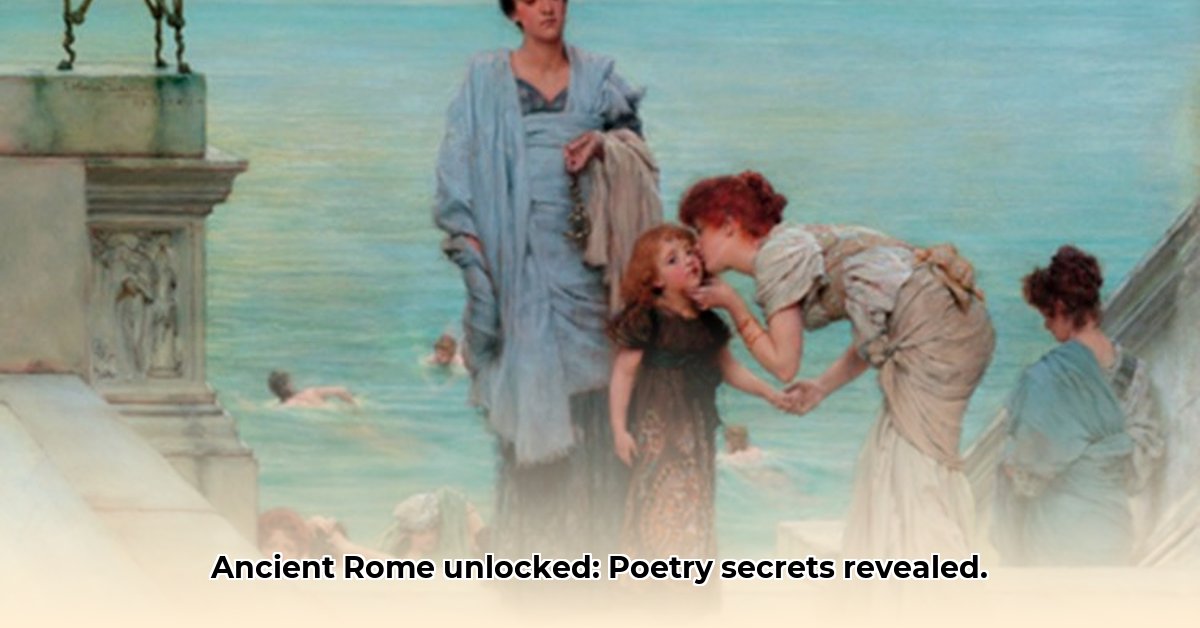Ever wondered what truly ignited the Roman soul? Beyond the grandeur of emperors and the roar of the Colosseum, ancient Roman poetry offers an unparalleled window into their deepest beliefs, daily lives, and the intricate fabric of their society. Explore more about Roman poets in this fascinating collection. Far from mere imitation, Roman poets, while profoundly influenced by Greek literary traditions, forged a distinctive artistic identity. They wove their own “Romaness” into inherited forms, creating a literary heritage that continues to resonate across millennia. This article embarks on a comprehensive exploration of this legacy, delving into the iconic works of classical authors from the vibrant “Golden Age” to the nuanced “Silver Age,” and examining the subtle mechanics of Latin verse that underpin their timeless art.
The Enduring Echo: A Poetic Legacy Unveiled
Ancient Roman poetry transcends mere historical artifact; it is a dynamic gateway to understanding a civilization that shaped Western thought. Roman writers, deeply respecting their Greek predecessors, engaged in a creative dialogue, adapting Hellenic genres and themes to express uniquely Roman experiences and values. This transformative process resulted in a rich literary canon that still informs our understanding of ancient literary forms and their profound impact.
Latin poetry masterfully employed sophisticated metrical structures and rhetorical devices. Analyzing these elements reveals a profound interplay between form and meaning, showcasing the Romans’ intellectual rigor and artistic sophistication. Roman literature progressed through distinct phases: from early influences to the flourishing Golden and Silver Ages, culminating in a gradual shift towards Christian themes.
The Golden Age: An Apex of Roman Literary Brilliance
The Golden Age of Roman Literature, spanning roughly from 1st Century BCE to the mid-1st Century CE, stands as a testament to unparalleled literary genius. This era, particularly under the reign of Augustus, was a period of stability and flourishing arts, nurturing a constellation of poets whose names remain synonymous with the height of ancient Roman literature. Each contributed a distinct voice, collectively weaving a rich and diverse literary tapestry.
Publius Vergilius Maro (Virgil) (70–19 BCE): Widely hailed as Rome’s national poet, Virgil composed the monumental Aeneid, an epic poem that masterfully intertwines Roman mythology with early Roman history. This saga of the Trojan hero Aeneas, destined to found Rome, provided the empire with a foundational narrative of heroism, duty, and divine favor, profoundly shaping Roman identity. His influence echoed for centuries, notably inspiring Dante Alighieri’s Divine Comedy. Virgil also penned the Eclogues, celebrating pastoral life, and the Georgics, a didactic poem on agriculture. To truly appreciate Virgil’s art, consider his iconic opening lines from the Aeneid: “Arma virumque cano, Troiae qui primus ab oris Italiam, fato profugus, Laviniaque venit litora.” In English, this translates to: “I sing of arms and the man, who first from the shores of Troy, exiled by fate, came to Italy and the Lavinian shores.” This single couplet immediately introduces themes of warfare, heroism, fate, and the grand destiny of Rome.
Publius Ovidius Naso (Ovid) (43 BCE–18 CE): Often regarded as the premier Roman love poet, Ovid captivated audiences with his vibrant and sometimes controversial verse. His Metamorphoses, a sweeping epic of over 15 books and 900 lines, seamlessly narrates 250 Greek and Roman myths, all linked by the theme of transformation. This work became a seminal influence for countless artists and writers from the Renaissance onward, providing a rich source of imagery and narrative. Ovid also produced the Amores, a humorous exploration of romantic adventures, and the Ars Amatoria (The Art of Love), a scandalous “how-to” guide on seduction. Esteban Berché wrote in National Geographic History that Ovid’s “frank poetic reflections on Roman sexual customs brought him fame but also played a role in his downfall.” Despite his immense popularity, Ovid was exiled by Emperor Augustus to Tomis (modern Constanța) on the Black Sea. The exact reason remains a puzzle for scholars, though Ovid himself attributed it to “carmen et error”—”a poem and an error.” Many scholars believe the “poem” was the Ars Amatoria, clashing with Augustus’s moral reforms. Ovid famously pined for Rome in his exile, and in a series of poems near his death, he asked for these lines to be placed on his tomb:
I who lie here was a writer
Of tales of tender love
Naso the poet, done in by my
Own ingenuity.
You who pass by, should you be
A lover, may you
Trouble yourself to say that Naso’s bones
May rest softly.Quintus Horatius Flaccus (Horace) (65–8 BCE): A contemporary of Virgil and a leading poet during the Augustan Age, Horace was renowned for his inventive lyricism. His Odes, a collection of four books, explore diverse themes including love, courage, friendship, and hymns to the gods, often reflecting Epicurean values of moderation and living in the moment. His Satires offer sharp criticisms of Roman vices, while his Epistles delve into philosophy and literary criticism. Horace is the source of many enduring phrases, most famously “Carpe diem” (“Seize the day”), urging readers to enjoy the present. He also wrote: “Quid sit futurum cras, fuge quaerere, et quem fors dierum cumque dabit, lucro adpone nec dulcis amores sperne, puer, neque tu choreas,“. This translates to: “Leave off asking what tomorrow will bring, and whatever days fortune will give, count them as profit, and while you’re young don’t scorn sweet love affairs and dances.”
Gaius Valerius Catullus (c. 85–c. 54 BCE): In stark contrast to the grandeur of epic, Catullus focused on intensely personal and intimate experiences. His short, often passionate, and sometimes scathing poems delve into the complexities of love, friendship, and loss, particularly his tumultuous affair with “Lesbia,” traditionally identified as Clodia. His work offers a raw, unfiltered glimpse into human emotion during a period of liberal politics and sexual freedom in Rome. John Porter of the University of Saskatchewan noted that Catullus’s poems reveal “private stories about the poet’s friendships with well-known figures, most notably Julius Caesar, and tell tales of love, friendship and sexuality.” His humor, satire, and profound humanity remain his most cherished qualities. Consider the famous opening of Catullus 5, a passionate plea to his lover to defy societal judgment:
Lesbia, come, let us live and love, and be deaf to the vile jabber of the ugly old fools, the sun may come up each day but when our star is out…our night, it shall last forever and give me a thousand kisses and a hundred more a thousand more again, and another hundred, another thousand, and again a hundred more, as we kiss these passionate thousands let us lose track; in our oblivion, we will avoid the watchful eyes of stupid, evil peasants hungry to figure out how many kisses we have kissed.Titus Lucretius Carus (c. 99–c. 55 BCE): A Roman poet and philosopher, Lucretius is primarily known for his sole surviving work, De Rerum Natura (On the Nature of Things). This lengthy didactic poem, divided into six books, offers a comprehensive poetic exploration of Epicurean philosophy, covering physics, the nature of the universe, and the development of the world. Lucretius famously argued that the universe operates according to rational laws and was not created by deities. Despite his deeply religious personal beliefs, his work was controversial in ancient Rome for challenging traditional religious views, and it later became influential among atheists.
Sextus Propertius (c. 50–15 BCE): Another significant contemporary of Virgil and Ovid, Propertius was a Latin elegiac poet best known for his Elegies. His work, often considered scandalous in his own time, explored themes of love, particularly his passionate but tumultuous relationship with “Cynthia,” and mythology. Unlike many of his peers, Propertius notably chose not to compose an epic celebrating Emperor Augustus, setting him apart.
Deep Dive: Unpacking a Verse from Virgil
To truly appreciate the artistry of Roman poetry, it is essential to understand its profound mechanics. Let’s revisit the opening lines of Virgil’s Aeneid for a more detailed analysis:
“Arma virumque cano, Troiae qui primus ab oris Italiam, fato profugus, Laviniaque venit litora.“
Meter (Dactylic Hexameter): Virgil here employs dactylic hexameter, the traditional poetic meter for epic poetry in both Greek and Latin. Each line is composed of six “feet.” A dactyl consists of one long syllable followed by two short ones (– U U), while a spondee consists of two long syllables (– –). The skillful variation of dactyls and spondees creates a majestic, flowing rhythm that enhances the poem’s epic scope and gravitas. For example, “Arma virumque” scans as – U U – –.
Elision: Roman poets frequently used elision to maintain the rhythmic flow of their verse. Elision occurs when a vowel or diphthong at the end of a word (and sometimes a word ending in ‘m’) is not counted metrically if the next word begins with a vowel, diphthong, or ‘h’. For instance, in “Italiam, fato profugus, Laviniaque venit litora,” the ‘-que’ would elide with ‘venit’ if they were adjacent and the meter required it.
Caesura: A caesura is a natural pause or break within a line of verse, often occurring in the middle of a foot. It can be marked by punctuation or simply a sense break, allowing the poet to vary the basic metrical pattern and introduce expressive pauses, making the reading more natural and dynamic.
This brief analysis showcases the meticulous craftsmanship Roman poets invested in their verses, carefully balancing sound, rhythm, and meaning.
The Silver Age: A Shift in Tone and Style
The Silver Age of Roman Literature, extending into the 2nd Century CE, witnessed a notable shift in literary style and thematic concerns. While still building on classical foundations, poets of this era often adopted a more dramatic, ornate, and sometimes rhetorical approach, reflecting the changing socio-political landscape of the Roman Empire. This period saw a rise in satire in Rome and a deeper introspection into the complexities of imperial life.
The most noticeable shift from the Golden to the Silver Age is in tone. While the Golden Age often conveyed a sense of idealism and national pride, the Silver Age frequently reflects the anxieties, cynicism, and moral scrutiny of life under increasingly autocratic imperial rule.
Lucius Annaeus Seneca the Younger (c. 4 BCE–65 CE): A prominent Stoic philosopher, statesman, and playwright, Seneca’s tragedies are characterized by their intense psychological torment and violent themes, offering a stark contrast to earlier dramatic works. His philosophical prose also influenced later European thought.
Marcus Annaeus Lucanus (Lucan) (39–65 CE): Seneca’s nephew, Lucan is known for his unfinished epic Pharsalia, which powerfully narrates the Roman Civil War between Caesar and Pompey. Unlike Virgil’s Aeneid, Lucan’s epic is devoid of divine intervention and presents a brutal, unflinching account of human conflict and political turmoil. Lucan’s involvement in a conspiracy against Emperor Nero unfortunately led to his premature death.
Gaius Plinius Caecilius Secundus (Pliny the Younger) (c. 61–c. 113 CE): Though primarily known for his eloquent letters, Pliny’s prose offers invaluable insights into the daily life, social customs, and political intrigues of the Roman elite during the early Empire. His writings are celebrated for their refined, classicized style.
Decimus Iunius Iuvenalis (Juvenal) (late 1st–early 2nd CE): A master of Roman satire, Juvenal’s Saturae offer a biting, often cynical, critique of Roman society, exposing its corruption, moral decay, and social absurdities with unflinching directness. His work is the origin of the phrase “bread and circuses” (panem et circenses).
The transition from the Golden to the Silver Age marks a natural evolution in Roman literary history, reflecting the unique challenges and concerns of a maturing empire. While later works were sometimes disparaged and labeled “Dog-Latin” by subsequent generations who perceived a decline in style, they remain vital for understanding the full scope of Roman literary history. This period also saw the gradual incorporation of Christian elements into Roman poetry as the empire underwent Christianization, reflecting a changing religious landscape and the adaptability of Roman literary forms.
Formal Elements of Latin Verse: Beyond the Words
To fully appreciate the sophisticated artistry of Latin verse, a grasp of its intrinsic mechanics is indispensable. Understanding poetic meter, elision, and other nuanced techniques unlocks a richer, deeper appreciation for classical poetry.
Latin verse is built upon quantitative meter, where rhythm is determined by the precise arrangement of long and short vowel sounds, rather than stressed and unstressed syllables as in English.
Feet: The fundamental building blocks of Latin verse are “feet,” which are combinations of long (–) and short (U) syllables.
- Spondee (– –): Two long syllables.
- Dactyl (– U U): One long syllable followed by two short syllables.
- Trochee (– U): One long syllable followed by one short syllable.
- Iamb (U –): One short syllable followed by one long syllable.
- Choriamb (– U U –): One long, two short, one long syllable.
Metres: Different combinations of these feet form distinct metres:
- Dactylic Hexameter: The epic metre, consisting of six feet per line, typically dactyls or spondees.
- Elegiac Couplets: A common metre for love poetry, comprising a line of dactylic hexameter followed by a line of dactylic pentameter (a modified form of hexameter).
- Hendecasyllabic Verse: A line of eleven syllables, often featuring a choriamb, favored by poets like Catullus and Martial for its light, conversational tone.
Elision: As noted, elision (known as synaloepha) occurs when a word ending in a vowel or diphthong (or ‘m’) is followed by a word beginning with a vowel, diphthong, or ‘h’. The first vowel (or the vowel before ‘m’) is not pronounced metrically, smoothing the flow of the verse.
Hiatus: The opposite of elision, hiatus occurs when a poet deliberately keeps two adjacent vowels separate metrically, creating a distinct pause or emphasis.
Caesura: A pause within a line, often coinciding with a sense break, which adds natural rhythm and allows for rhetorical emphasis.
Other Noteworthy Voices:
- Sulpicia (late 1st century BCE): The only surviving female Roman poet, whose six poems, preserved within the Corpus Tibullianum, offer a rare aristocratic female voice from the Augustan era, exploring personal themes of love and longing.
- Marcus Valerius Martialis (c. 40–c. 104 CE): One of the most significant epigrammatists, known for his witty, often cynical, and sometimes obscene short poems that satirized Roman life. He frequently employed the Phalaecian hendecasyllable.
Decoding Ancient Voices: How to Analyze Latin Poetry
For aspiring scholars and enthusiasts, understanding how to analyze Latin poetry begins with deciphering its quantitative meter and appreciating its rhetorical nuances. Mastering this rhythm is key to unlocking its enduring beauty and sophisticated meaning.
Key Steps to Analyzing Latin Poetry:
- Understand Metrical Principles: Familiarize yourself with the core quantitative feet (dactyl, spondee, trochee, iamb) and common metres (dactylic hexameter, elegiac couplets). Recognize how long and short syllables are determined by vowel length and position.
- Practice Scansion: Scansion is the process of marking the metrical pattern of a verse. Utilize online tools and exercises (many university classics departments offer resources, such as Dr. Chamberlain’s website mentioned in the original source) to practice identifying feet, elisions, and caesurae. This hands-on practice trains your ear to the rhythm.
- Identify Poetic Devices: Look for literary techniques such as alliteration, assonance, chiasmus (ABBA word order), anaphora (repetition of words at the beginning of clauses), and synchysis (interlocked word order). These devices contribute to both the sound and the meaning of the poem.
- Contextualize: Research the historical, social, and political context of the poem’s creation. Understand the poet’s life, influences, and the specific events or philosophies they might be addressing.
- Translate and Interpret: A literal translation is a starting point, but delve into deeper interpretations. Consider the poet’s tone, themes, and underlying messages. Discuss your interpretations with peers in online forums or study groups to deepen understanding.
Legacy and Influence: Echoes Through the Ages
Ancient Rome poetry, particularly from its Golden and Silver Ages, remains a vibrant subject of academic inquiry and artistic inspiration. Scholars meticulously analyze these verses for their artistic merit,










